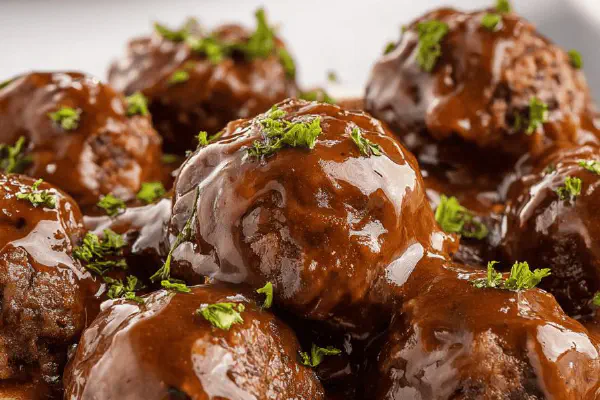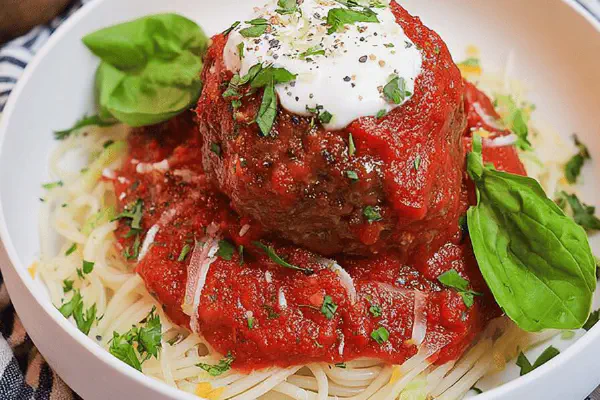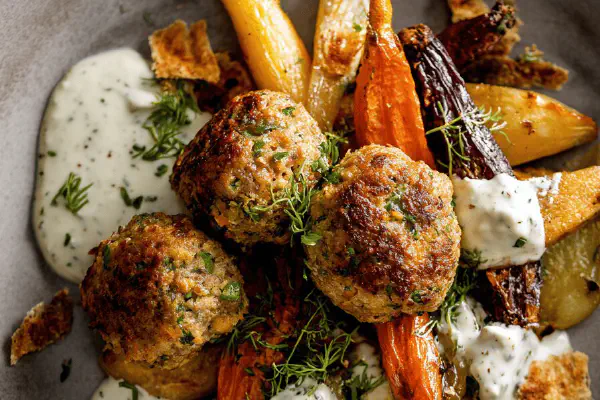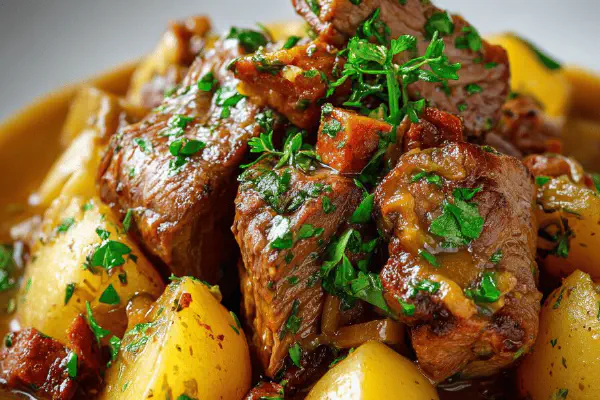Swedish Meatballs Reworked

By Emma
Certified Culinary Professional
Ingredients
- 80 g (1/3 cup) fresh bread crumbs
- 1 medium shallot, finely chopped
- 45 ml (3 tbsp) duck fat or clarified butter
- 300 g (2/3 lb) ground veal
- 380 g (14 oz) lean ground beef
- 75 ml (1/3 cup) whole milk
- 1 large egg
- 1/2 ml (1/8 tsp) ground allspice
- 1 pinch freshly ground black pepper
- 30 ml (2 tbsp) unsalted butter
- 35 ml (2 1/3 tbsp) all-purpose flour
- 300 ml (1 1/4 cups) chicken stock
- 75 ml (1/3 cup) crème fraîche or sour cream
About the ingredients
Method
- Dry-toast breadcrumbs in a large nonstick skillet over medium-high heat until golden, stirring constantly; smells nutty and toasty; remove and place in large bowl.
- Use the same skillet, lower heat to medium, add duck fat and sweat shallots gently; translucent and soft without browning, season with salt and pepper; transfer to bowl with breadcrumbs; allow to cool slightly — hot onions will scramble the egg later.
- Add veal and beef, milk, egg, allspice, and pepper to breadcrumbs-shallot mix; combine thoroughly but don’t overwork; mixture should be sticky but not sloppy — too wet means more crumbs or a touch more flour.
- Hand-shape mixture into golf-ball-sized spheres, about 18-20 pieces; place on plate ready for frying.
- Heat remaining duck fat and butter over medium heat; brown meatballs in batches so they don’t steam — each side about 3-4 minutes till rich mahogany crust forms; don’t rush or crowd pan; transfer browned meatballs to a warm plate.
- Sprinkle flour over rendered fat in skillet, stir vigorously for 2 minutes; golden, slightly nutty aroma signals proper browning; slowly whisk in chicken stock and crème fraîche, scraping pan bottom for flavorful bits; bring sauce to gentle boil, stir constantly.
- Return meatballs to sauce; cover loosely and lower heat to simmer; cook about 8-10 minutes until meatballs firm, internal temp near 70°C (160°F); sauce thickens slightly; if too thick, add broth in small bursts.
- Taste sauce for seasoning — add salt or pepper if needed. Serve with creamy mashed potatoes; classic touch: lingonberry or cranberry jam on the side to cut richness.
Cooking tips
Chef's notes
- 💡 Dry-toast breadcrumbs slowly on medium-high, watch color and smell—nutty aroma signals readiness. No shortcuts here; burnt crumbs ruin texture. Stir constantly; pan hot spots burn edges fast but not center. Use fresh crumbs only. Dried pre-packaged crumbs sog too easily, no crust.
- 💡 Sweat shallots gently in duck fat over medium heat, no browning. Soft translucent texture means sweet flavor, not sharp. If pan too hot, onions crisp or scorch. Volume expands; pan size matters. Cool onions fast after to avoid cooking egg in next step, else scrambled surprises.
- 💡 Mix meats, milk, egg, and spices lightly with crumbs—overmixing tightens protein, makes balls tough. Sticky but firm mix key; too wet adds more crumbs or a little flour, not both. Testing by squeeze feel not exact measurements. Shape golf ball size, smaller cooks more evenly, less raw center risk.
- 💡 Brown meatballs in batches to avoid steaming; hear sizzle, smell crust forming. Each side gets 3-4 minutes; too fast and outside burns, too slow pan cools, meat steams gray. Keep space, don’t crowd. Transfer browned meatballs to warm plate quickly to rest before saucing.
- 💡 Roux starts with flour in leftover fat; must brown to amber for flavor. Smell is your guide—nutty, toasted with no bitterness. Stir constantly 2 minutes to unlock richness. Adding stock slowly avoids lumps. Scrape pan bottom; browned bits are flavor power. Sauce should bubble gently, not boil loud, else toughness.
Common questions
Can I swap veal with beef or pork?
Yes, veal subtle but beef or pork works. Beef gives firmer texture, pork fattier flavor. Mixing all three ok too, balance depends on what you want. Substitutes change cooking times slightly.
What’s the best way to brown meatballs evenly?
Heat medium, batches, leave space. Sizzle sounds tell when ready. No crowding or steam traps form, crust fails. Adjust heat if smoke, reduce flame—too hot burns, too low steams meat. Patience key.
My sauce turned gluey, what happened?
Could be roux overcooked or too much flour. Too dark and bitter, too pale no flavor. Sauce needs gentle simmer with cream acidity. Thin with stock if too thick. Stir frequently to avoid lumps.
How to store leftovers?
Refrigerate for 2-3 days in airtight. Reheat low and slow, add splash stock or water to avoid drying. Freeze cooked meatballs and sauce separately works well; thaw in fridge overnight. Reheat thoroughly but avoid overcooking sauce.



